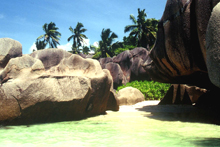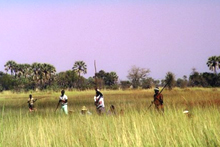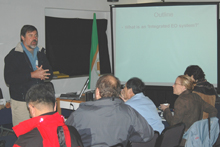Seeking a common path forward in environmental research and observation
Editorial by Prof Tim O'Connor, Observation Science Specialist, SAEON
The Namib Desert, resplendent in a dense cloak of grass as a result of the heaviest rainfall in 30 years, seemed an appropriate setting for a meeting to discuss long-term environmental research and observation. A rainfall year of such magnitude is a rare event, and the long-term monitoring of the Gobabeb Research and Training Centre has captured many of its ecological ramifications.
|
Whether fortuitous or an omen, the new-found productivity of the usually bare gravel plains of the desert portended an equivalent productivity of the ELTOSA and ILTER members who met to share experiences and seek a common path forward.
Dr Mary Seely of Desert Research Foundation of Namibia and Dr Bob Scholes of the Council for Scientific and Industrial Research (CSIR) struck a common theme in their keynote addresses concerning the importance of widespread observation systems rather than site-restricted research efforts in addressing environmental challenges. Both presented the case that observation should respond to user-defined needs.
Dr Scholes, who is a CSIR research fellow and member of the SAEON Technical Steering Committee, emphasised that satellite-based approaches have to be complemented with ground-truthed data, both of which have to be processed together through an appropriate model in order to provide simplified outputs suitable for use by a non-scientific decision maker. The approach was illustrated by intriguing examples of research conducted by the CSIR in predicting fire damage, cholera outbreaks, and firewood shortages in southern Africa.
Dr Seely took the importance of ground-based data one step further. Her talk was a refreshing example of the power of an observation system that does not require hi-tech input. The Desert Research Foundation of Namibia has responded to the user need of sustainable livelihoods in the semi-arid and arid regions of the country through harnessing the collective efforts of locals for monitoring water and range resources using only simple charts designed for the purpose. Monitoring of resource consumption or depletion directly by affected communities has enabled adaptive decision making by them, certainly a pointer for future implementation elsewhere of adaptive strategies in order to accommodate environmental change.
Delegates sought to identify areas of greatest common interest among the plethora of environmental issues facing their respective countries, first at a regional then at an international level. Potential candidates included the expected contemporary research ‘hot-spots' of climate change, biodiversity, land-use change, and desertification, amongst others. ELTOSA delegates were not hesitant in identifying water-related issues as an initial vehicle for a collaborative research effort in the sub-region. Interest stemmed from a shared experience of ever increasing demands on water and catchments that threatened livelihoods and had potential downstream consequences for biodiversity and ecosystem functioning.
The spectre of drought occasionally interspersed with flood is a hallmark of southern Africa. Transformation of Malawi's catchments, landslides, and increased sediment load in rivers threaten food security and the globally significant cichlid fishes of Lake Malawi. Botswana's renowned Okavango swamps, a RAMSAR site, may soon be impacted by upstream water extraction and catchment development. South African media regularly portray aquatic systems in distress, such as St Lucia, the Orange River delta, and Kosi Bay. Even the verdant Seychelles islands face ongoing water shortages because a large, protruding granite block rapidly sheds most incident rainfall.
Although not necessarily the number one priority of most ILTER members, water-related issues were sufficiently prominent on their agendas for ILTER to accept a common proposal for a collaborative research effort addressing water, biodiversity, and resilience of related ecosystem services. This initiative dovetails with the key themes of SAEON, thus ensuring dual participation in an international effort whilst achieving national objectives.













